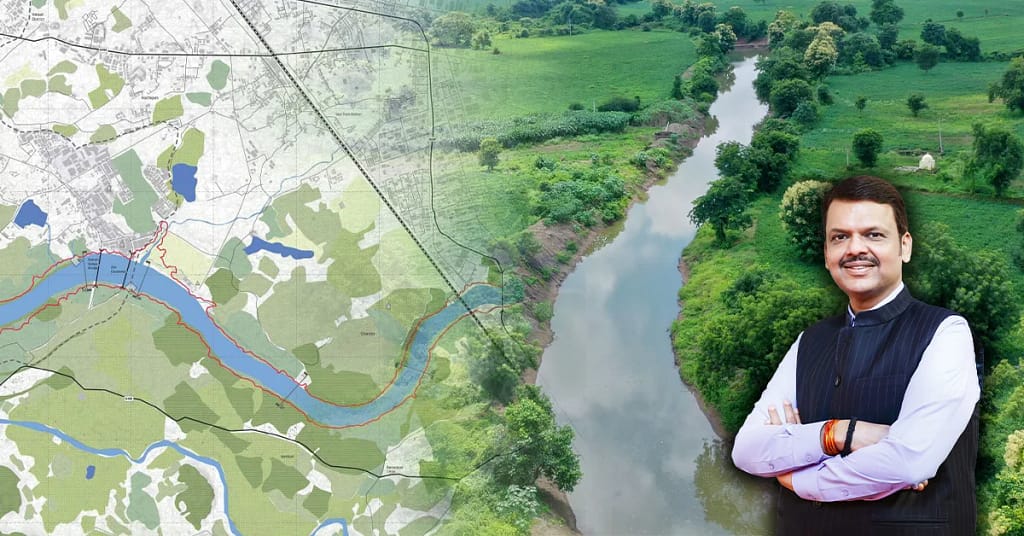Maharashtra is a state of asymmetric climate and water availability that causes floods in the western part and drought in the central and east. The River Linking Project is a revolutionary initiative that will recharge the dried-up rivers and reservoirs in the east with the excess floodwater from the western rivers. This is a massive project aimed at boosting water conservation and management in the state and revitalizing agriculture and industries in eastern Maharashtra, which face serious problems due to an acute water shortage. Maharashtra’s Chief Minister, Devendra Fadnavis, who initiated the river-linking project, emphasized the importance of effectively executing the project to address water scarcity in the state. Following the successful implementation of the Jalyukt Shivar Yojana, the government’s focus is now on the River Linking Project to ensure all-time water availability in drought-prone areas. Currently, work is progressing swiftly on the River Linking Projects, which encompass several districts in Vidarbha, Marathwada, and North Maharashtra. Upon completion of this initiative, residents of these regions will experience significant relief. The primary aim of the River Linking Project is to supply ample water for agriculture by efficiently reallocating water resources and managing flood-related issues. In this article, we will examine the initiative launched by Devendra Fadnavis, recognized as Maharashtra’s Waterman.
History of the River Linking Project
The first concept of the river-linking project was proposed by Arthur Cotton, a British engineer of the then Madras Presidency, in 1919. He thought of connecting the Godavari River flowing from Dholashveram with the Krishna River of Vijayawada. Then, in 1935, Sir Visvesvaraya, and after 1960, the then Minister of State for Irrigation, K.L. Rao, also prepared similar proposals. Later, Prime Minister Indira Gandhi established the National Water Development Agency to study this proposal, but it did not go any further. Finally, in 1999, the NDA government led by the then Prime Minister Atal Bihari Vajpayee formed a task force under the chairmanship of Suresh Prabhu to get this project off the ground. Through this task force, Suresh Prabhu held several meetings and toured many places in the country to prepare an action plan for the river-linking project. But at that juncture, the Atal Bihari Vajpayee government was replaced by the Congress-led UPA government at the Center, which resulted in dropping this project. The river-linking project again came to light when the BJP included it in their 2014 election manifesto. The victorious BJP came to power with Narendra Modi as Prime Minister.
The government under Prime Minister Narendra Modi constituted a special committee under the chairmanship of the Union Minister of Water Resources, as per the directions given by the Supreme Court on 27 February 2012 regarding the ILR (Interlinking of Rivers) project. This committee conducted a detailed study on river-linking and submitted reports on the 14 Himalayan and 16 perennial rivers. The implementation of river-linking projects began. While the Ken-Betwa river linking project, which falls under the two states of Uttar Pradesh and Madhya Pradesh, became the first interstate river linking project at the national level, the Polavaram river-linking project on the Krishna and Godavari rivers in Andhra Pradesh is considered the first intrastate river linking project.
The river-linking project began in Maharashtra
An experimental water-diversion project was first undertaken in the Jalgaon district. The then District Collector of Jalgaon and officials of the Water Resources Department had implemented a different type of irrigation experiment in 2005 to overcome the water shortage in the district. In this, floodwater flowing from rivers during the monsoon was diverted to far-off irrigation projects with the help of drains, streams, and canals. As a result, more than 16 thousand irrigation wells in the drought-hit areas were replenished through this experiment. The success of this experiment later inspired Devendra Fadnavis, after he became the Chief Minister of Maharashtra, to implement the river-interlinking concept for flood and drought control across the state. Meanwhile, with the Modi government at the center, the implementation of the river interlinking project, ILR, got underway at the national level. But since that would be a large and time-consuming plan involving many aspects at a much higher cost, the Fadnavis government decided to take up the local-level projects of interconnecting rivers and water basins in the districts by incorporating the Jalgaon District River Interconnection Project policy in the district annual plans in 2017, through a government decision issued on 23 August 2017 initiating the start of the project work. In 2018, four intrastate and one interstate river interconnection projects were given in-principle approval. The river-linking projects of Fadnavis will always be regarded as landmark initiatives of water management in Maharashtra.
Decision to divert water from Konkan to Marathwada | Marathwada Nadi Jod Prakalp
From 2014 to 2019, many districts in Marathwada had to face severe water deficits. Against this backdrop, the Devendra Fadnavis government approved a proposal in 2018 to divert water from the river basins of the western part of the state to the Godavari basin in Marathwada through the river interconnection projects. Accordingly, it was decided to implement the one interstate ILR project, between the Damanganga and Pinjal rivers, and the four intrastate ILR projects, namely the Nar-Par-Girna, Par Godavari, Damanganga-Vaitarna-Godavari, and Damanganga-Ekdare-Godavari, from state funds instead of implementing them as national projects. Through these river interconnection projects, it was decided to make 31.60 billion cubic feet of water available for Mumbai city, 25.60 billion cubic feet for Marathwada, and 10.76 billion cubic feet for the Tapi valley from Konkan. A separate mechanism was created to coordinate these river interconnection projects at the state level and bring uniformity to them.
Promotion of Wainganga-Nalganga and Nar-Par-Girna river linking projects
In a cabinet meeting held in 2024, the Vainganga-Nalganga (Vainganga Nalganga Nadi Jod Prakalp) and Nar-Par-Girna (Nar Par Girna Nadi Jod Prakalp) river linking projects were approved to improve irrigation in Marathwada and Vidarbha. The state government approved these projects for a cost of Rs 87,342.86 crore and Rs 7,015 crore, respectively. The Vainganga-Nalganga river-linking project will make western Vidarbha drought-free by transporting water from the Gosikhurd National Irrigation Project to western Vidarbha. About 400 to 500 km of new canals will be constructed for this project, which will bring 10 lakh acres of land under irrigation in the future.
The Nar-Par-Girna River Interconnection Project will store 10.64 TMC of water from the basins of three rivers, namely the Nar, Par, and Auranga, by constructing dams at 9 different places in the Surgana taluka of Nashik. Later, this stored water will be pumped and released into the Girna basin. This project will benefit a total of 49,516 hectares of land, including 32,492 hectares in the Surgana, Kalvan, Deola, and Malegaon talukas of Nashik and 17,024 hectares of land in Bhadgaon, Erandol, and Chalisgaon in Jalgaon.
Through the river interconnection project, excess water from the regions receiving abundant rainfall will be collected and diverted to the water-scarce areas. This will help in controlling floods in some areas caused by excess water, as well as droughts in water-scarce areas.
Related articles:

